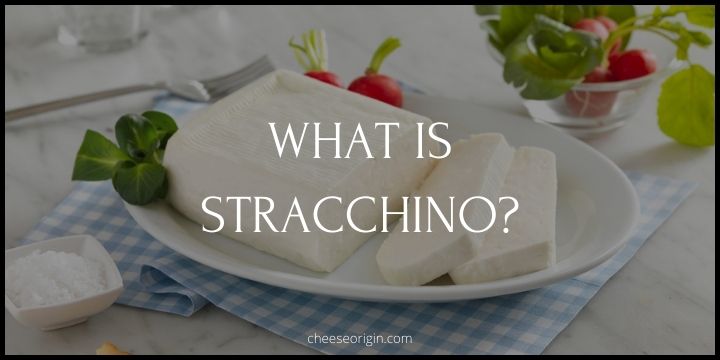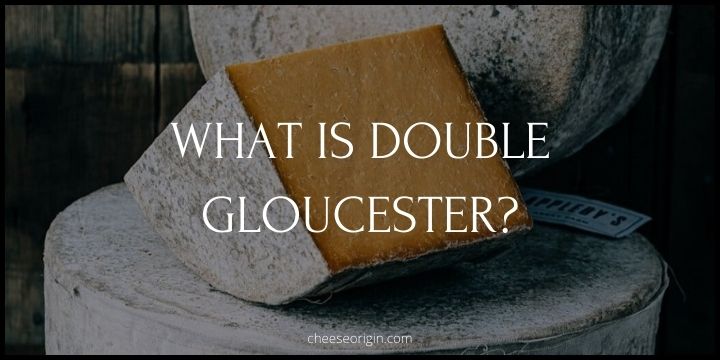What is Mozzarella? The Milky Delight at the Heart of Italian Cuisine
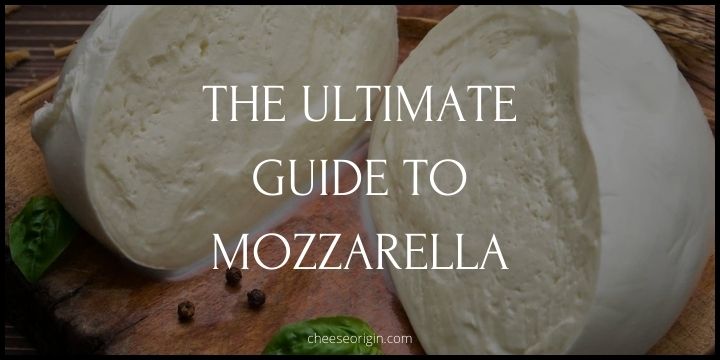
Welcome to our ultimate guide to Mozzarella, the star of Italian cuisine and the heart of countless mouthwatering dishes around the world. From its humble beginnings in Southern Italy to its current status as a global culinary staple, the journey of Mozzarella is a fascinating tale of tradition, innovation, and gastronomical delight.
In this guide, we’ll delve into everything you need to know about Mozzarella. We’ll explore its rich history, the traditional process of making it, and the many different types that exist. We’ll also share some insider tips on how to choose the best Mozzarella, how to store it properly, and how to use it in your cooking to create truly irresistible dishes.
Quick Facts About Mozzarella
| Fact | Description |
|---|---|
| Origin | Italy |
| Milk Source | Traditionally from Italian Mediterranean buffalo, but also made from cow’s milk |
| Texture | Semi-soft, elastic |
| Flavor | Mild, milky |
| Color | White |
| Aging Process | Fresh cheese, usually consumed within few hours to a few days of production |
| Protected Designation of Origin | Mozzarella di Bufala Campana has been registered as a Protected Designation of Origin (PDO) under EU law since 1996. Fior di latte (made from cow’s milk) is not under PDO protection |
| Historical Origins | The production of mozzarella dates back to at least the 12th Century in Capua and the 16th Century in Naples in the Campania region of Italy |
| Uses | Pizza, caprese salad, pasta dishes, served with tomatoes and basil |
What is Mozzarella?
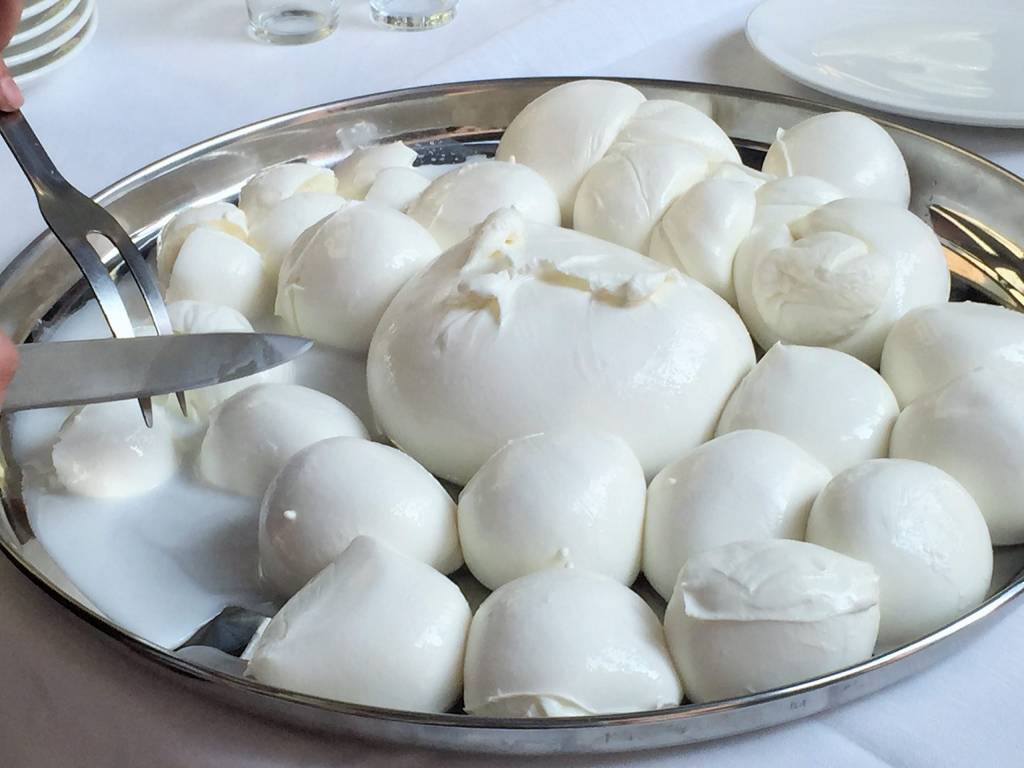
Mozzarella is a traditional southern Italian cheese made from the milk of water buffalos or cows. Known for its soft, moist texture and mild yet tangy taste, it has become one of the most popular cheeses worldwide.
The production process of Mozzarella is quite unique. It involves a technique called pasta filata, which translates to “spun paste.” The curd is heated in warm whey until it becomes elastic. It’s then kneaded and pulled to develop its characteristic stretchy texture. Once the desired consistency is achieved, the cheese is shaped into balls, often by hand, and then stored in brine or whey to maintain its moisture and softness.
One of the defining characteristics of Mozzarella is its high moisture content, which gives the cheese its soft, creamy texture. When heated, it melts beautifully, making it a staple ingredient in dishes like pizza and lasagna. But it’s not just limited to hot dishes; fresh Mozzarella is also fantastic in cold salads, paired with tomatoes and basil for a classic Caprese salad.
Mozzarella is a nutritious food, providing a good source of protein and calcium. However, its fat content can be high, particularly in versions made from whole milk, so moderation is key.
There are several types of Mozzarella, including Mozzarella di Bufala (made from buffalo milk and known for its rich and creamy flavor), Fior di Latte (made from cow’s milk), and Burrata (a fresh Italian cheese that contains a creamy center).
What Does Mozzarella Taste Like?
Mozzarella cheese has a subtle, mild flavor that can be described as slightly tangy and milky. It’s not overly salty or sharp like some other cheeses, making it a perfect complement to stronger flavors in various dishes.
The taste of Mozzarella is often influenced by its freshness. Fresh Mozzarella, which is typically stored in brine, whey, or water, has a clean, slightly sweet, and tangy taste with a hint of lactic flavor. It also has a creamy, delicate texture that’s quite different from the semi-soft, slightly rubbery texture of low-moisture Mozzarella.
Low-moisture Mozzarella, the type often used on pizza, has a denser texture and a more pronounced flavor due to the longer aging process. When melted, it becomes stretchy and gooey with a mild, creamy, and slightly salty taste.
Mozzarella made from buffalo milk, known as Mozzarella di Bufala, has a richer flavor and creamier texture compared to the cow’s milk variety. It offers a subtle sweetness balanced by a tangy finish.
Overall, the taste of Mozzarella is understated and versatile, allowing it to blend well with a wide array of ingredients without overpowering them.
Mozzarella Tasting Notes
- Texture: Fresh Mozzarella is soft, moist, and creamy with a slightly elastic feel. Low-moisture Mozzarella is semi-soft and firm but becomes stretchy when melted.
- Color: Fresh Mozzarella is bright white, while low-moisture Mozzarella can range from white to light yellow depending on the type of milk used and the aging process.
- Aroma: The aroma is mild, often reminiscent of fresh milk or cream. There’s usually no strong smell unless it’s aged or smoked Mozzarella.
- Taste: Mozzarella has a delicate, milky flavor with a slight tanginess. The saltiness varies depending on whether it’s stored in brine or not. Mozzarella di Bufala tends to have a richer, creamier taste with a subtle sweetness.
- Aftertaste: The aftertaste is generally clean and fresh, with a lingering creaminess.
- Mouthfeel: Fresh Mozzarella has a high moisture content, giving it a creamy, smooth texture. Low-moisture Mozzarella is denser and firmer but becomes gooey when melted.
- Variations: Mozzarella di Bufala has a more robust flavor profile compared to regular Mozzarella. Smoked Mozzarella has a distinct smoky flavor that adds depth to its mild taste.
- Pairings: Mozzarella pairs well with tomatoes, basil, and olive oil in a Caprese salad. It’s also excellent with cured meats, olives, and crusty bread. On the sweeter side, it can be served with peaches or melon. Its melting qualities make it a star in hot dishes like pizza, lasagna, and baked pasta.
What are the 7 Different Types of Mozzarella?
| Mozzarella Type | Description |
|---|---|
| Mozzarella di Bufala | Made from buffalo milk, it’s creamy and slightly tangy. Ideal for salads or eaten alone. |
| Fior di Latte | Made from cow’s milk, it’s firm and mild. Commonly used in cooking, particularly pizza. |
| Burrata | A mix of mozzarella and cream. The outer shell is solid mozzarella, while the inside is soft. Typically served fresh. |
| Low-Moisture Mozzarella | Undergoes longer drying process, resulting in firmer texture and longer shelf life. Widely used in American-style pizzas. |
| Smoked Mozzarella (Mozzarella Affumicata) | Smoked version of mozzarella with a distinctive smoky flavor. Adds a unique taste to dishes. |
| Bocconcini | Small balls of mozzarella, often used in salads or appetizers. |
| Ciliegine | Bite-sized mozzarella balls, perfect for snacking or adding to salads. |
Mozzarella is a versatile cheese that comes in various types, each with its unique characteristics and uses.
Must read: 12 Different Types of Mozzarella: From Creamy to Crisp
Here are some of the most popular types of Mozzarella:
1. Mozzarella di Bufala:
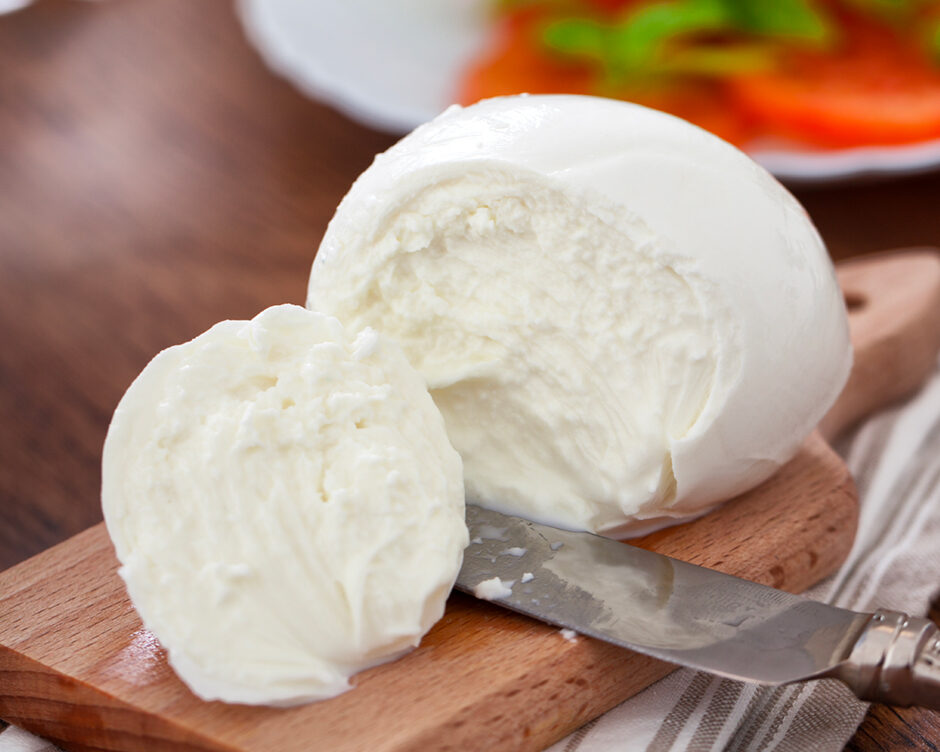
This is the original form of Mozzarella, made from the milk of water buffaloes in the Campania region of Italy. It has a creamy texture and a slightly tangy flavor. Mozzarella di Bufala is often used in salads or eaten on its own.
2. Fior di Latte:
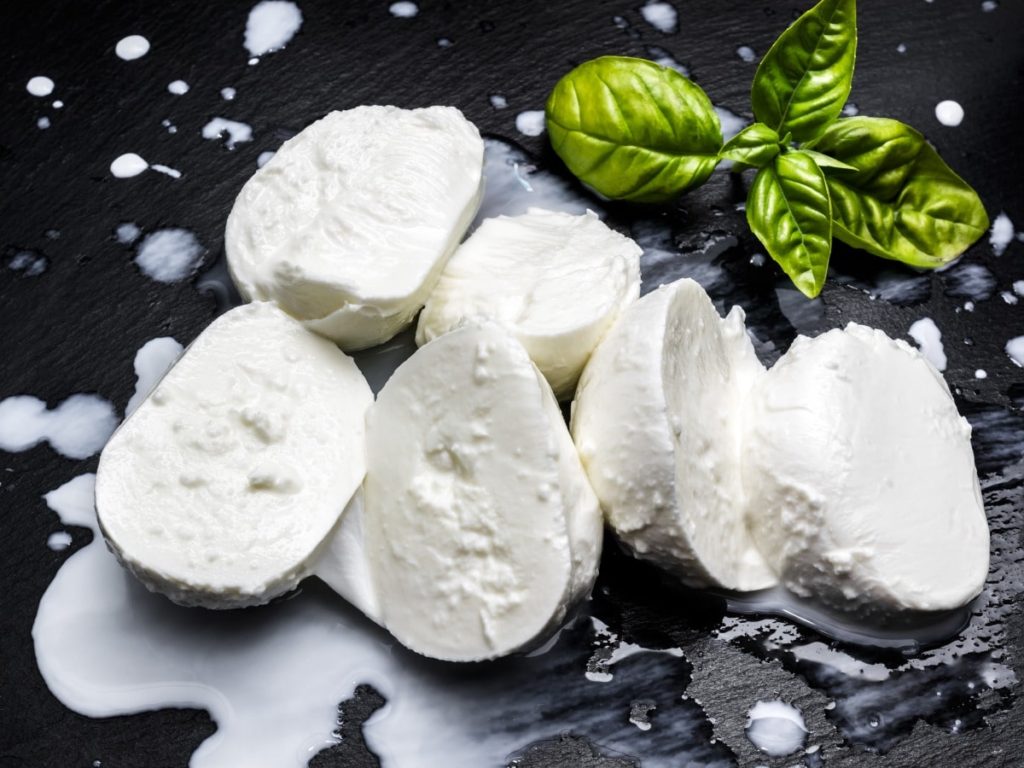
This type of Mozzarella is made from cow’s milk, which is more widely available than buffalo milk. Fior di Latte has a firm texture and a mild flavor. It’s commonly used in cooking, especially on pizza.
3. Burrata:
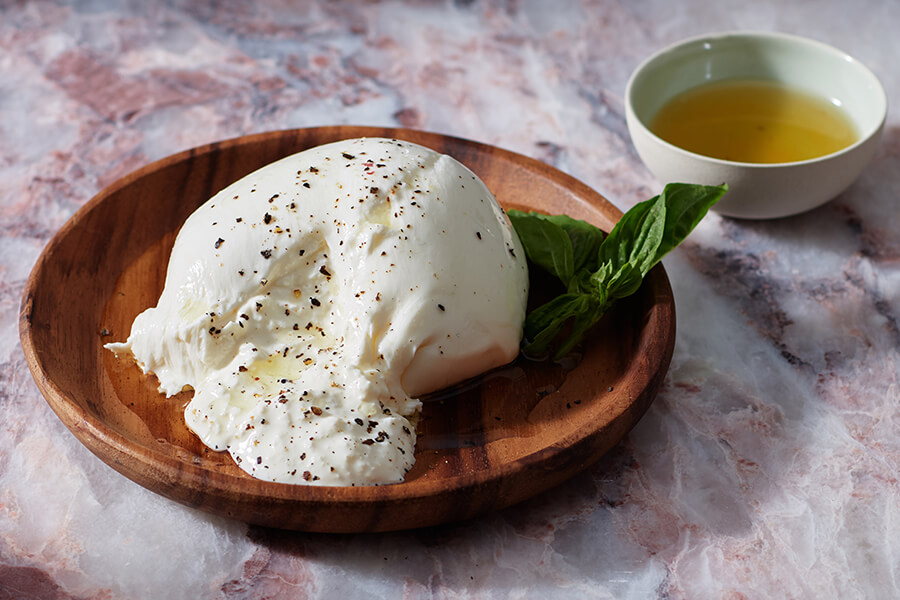
A relative of Mozzarella, Burrata is a fresh Italian cheese made from Mozzarella and cream. The outer shell is solid Mozzarella, while the inside contains stracciatella and cream, giving it an unusually soft texture. Burrata is typically served fresh, often with tomatoes and basil.
4. Low-Moisture Mozzarella:

This variant undergoes a longer drying process, resulting in a cheese with lower water content. It has a firmer texture and a longer shelf life than fresh Mozzarella. Low-moisture Mozzarella is widely used in the food industry, particularly in American-style pizzas.
5. Smoked Mozzarella (Mozzarella Affumicata):

As the name suggests, this Mozzarella is smoked, giving it a distinctive smoky flavor. It can be used in a variety of dishes to add a unique taste.
6. Bocconcini:
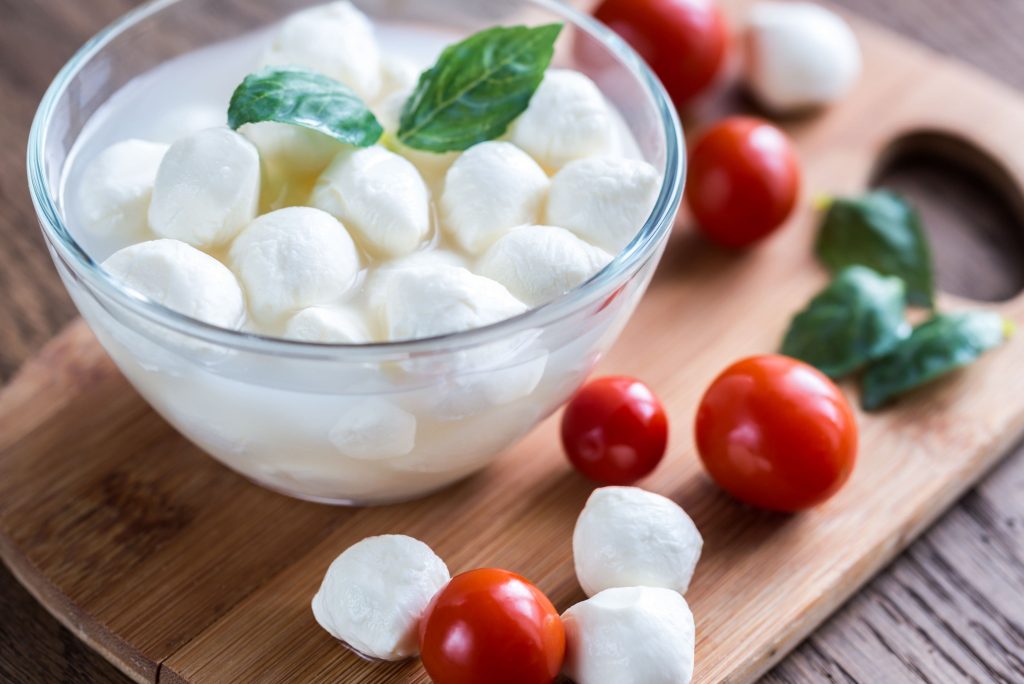
These are small balls of Mozzarella, about the size of an egg. Bocconcini are usually used in salads or appetizers, often paired with cherry tomatoes and fresh basil.
7. Ciliegine:

Similar to Bocconcini but smaller, Ciliegine (“little cherries” in Italian) are bite-sized balls of Mozzarella that are perfect for snacking or adding to salads.
Each type of Mozzarella brings something unique to the table, making it a versatile ingredient in a wide range of dishes. Whether you prefer the creamy richness of Mozzarella di Bufala, the mild versatility of Fior di Latte, or the smoky depth of Mozzarella Affumicata, there’s a Mozzarella to suit every palate.
How to Choose the Best Mozzarella
1. Understand the Types:
As we’ve discussed earlier, there are several types of Mozzarella, each with its own characteristics.
For instance, if you’re making a classic Margherita pizza, you might want to go for Fior di Latte or low-moisture Mozzarella.
But if you’re preparing a Caprese salad, you may prefer the creaminess of Mozzarella di Bufala.
2. Check the Freshness:
Fresh Mozzarella should have a milky, light aroma. Avoid any cheese that has an overly sour smell or appears dry, as this could indicate it’s past its prime.
3. Look at the Packaging:
If you’re buying pre-packaged Mozzarella, make sure it’s in a well-sealed package with some liquid (whey or water). This liquid helps keep the cheese fresh and moist.
4. Consider the Texture:
The texture of Mozzarella can tell you a lot about its quality. High-quality fresh Mozzarella should be soft but firm, and when sliced, it should release a bit of milky whey.
5. Taste it:
If possible, taste the Mozzarella before buying. It should taste clean and milky, with a slight hint of tanginess.
6. Buy from a Reputable Source:
Whether it’s a trusted local cheese shop, a good supermarket, or a reliable online vendor, make sure you’re buying from a source that knows how to handle and store cheese properly.
How to Store Mozzarella Properly
| How to Store Mozzarella Properly | Instructions |
|---|---|
| Refrigeration | Store in the refrigerator as soon as possible. |
| Use an Airtight Container | Once opened, store in an airtight container to prevent drying out. |
| Store in Liquid | Store in its original liquid (brine, whey, or water) for up to five days. |
| Wrap Tightly in Plastic Wrap | If you don’t have an airtight container, use plastic wrap. |
| Freeze for Longer Storage | For extended storage, freeze the cheese. Note: this may alter the texture. |
| Check Regularly | Check for signs of spoilage such as mold, sour smell, or changes in color and texture. |
Is Mozzarella a Healthy Cheese?
Yes, mozzarella is considered a healthy cheese. It is a good source of protein, calcium, and phosphorus, essential nutrients for optimal health.
Mozzarella is lower in sodium and calories than most other cheeses and contains probiotics that may benefit your immune system.
It’s also relatively low in fat, making it a healthier substitute for other cheeses. Additionally, mozzarella cheese helps to support bone strength due to its calcium content.
However, like all foods, it should be consumed in moderation as part of a balanced diet.
For more info about whether Mozzarella is healthy, read these 2 articles by certified personnel:
- Is Mozzarella Cheese Healthy? Here’s What a Dietitian Says – EatingWell.com
- The 9 Healthiest Types of Cheese – Healthline.com
The protein and nutrients in mozzarella cheese: Nutrition facts
Key nutrients in a 100-gram serving:
| Nutrient | Quantity |
|---|---|
| Protein | 22.17g |
| Calcium | 505mg |
| Vitamin A | 242IU |
| Vitamin B12 | 0.65µg |
| Potassium | 76mg |
| Sodium | 373mg |
| Total Fat | 22.35g |
| Saturated Fat | 13.10g |
| Cholesterol | 79mg |
Can I eat fresh Mozzarella every day?
Mozzarella is also a source of calcium, protein, and other essential nutrients. However, its high sodium content can contribute to high blood pressure if too much is consumed.
The key is balance. Incorporating a variety of nutrient-dense foods into your diet is beneficial for overall health. If you enjoy eating fresh mozzarella, consider having it in small portions and pair it with fruits, vegetables, whole grains, and lean proteins.
As with any dietary concerns, it’s always best to consult with a healthcare provider or a registered dietitian for personalized advice.
What is Mozzarella Cheese Mostly Used For?
| Cooking Method | Description |
|---|---|
| Pizza | Use mozzarella for many types of pizza. Sprinkle on dough with toppings, bake until golden. |
| Pasta | Toss mozzarella into hot pasta dishes for gooey strands. Key in lasagna and baked pasta. |
| Salads | Fresh mozzarella is great in salads, especially Caprese with tomatoes, basil, olive oil, and vinegar. |
| Appetizers | Use small mozzarella balls for appetizers. Marinate in olive oil and herbs, or skewer with tomatoes and basil. |
| Stuffed Dishes | Use mozzarella as a filling in dishes like stuffed peppers, mushrooms, or chicken breasts. |
| Grilled Cheese Sandwich | Swap cheddar or American cheese for mozzarella for a different take on this classic. |
| Baked Goods | Add mozzarella to savory baked goods like bread and muffin for a cheesy twist. |
| Melts | Use mozzarella in any dish where you want a good melt – like quesadillas, nachos, or baked dips. |
What goes well with Mozzarella? Pairing guide
Foods that go well with Mozzarella
| Category | Food |
|---|---|
| Fruits and Vegetables | Sliced Tomatoes, Peaches, Radishes, Cucumbers, Plums, Nectarines, Zucchini, Snap Peas, Cantaloupe |
| Salads | Caprese Salad, Peach & Burrata Caprese, Buffalo Chicken Salad Sliders |
| Pizzas | White Pizza, Mushroom And Tomato Mini Pizzas, Pizza with Homemade Sauce |
| Bread | Cheesy Garlic Bread, Garlic Bread |
| Meat Dishes | Cheesy Bacon Ranch Chicken, Baked Meatballs |
| Pasta | Italian Pasta Salad |
| Snacks/Appetizers | Mozzarella Sticks, Potato Croquettes, Bacon Wrapped Mozzarella Sticks |
| Side Dishes | Onions, Mushrooms, Eggplants, Roasted Peppers, Spinach |
| Other | Barilla Lasagna, Tomato with Mozzarella & Parmesan, Chicken Nuggets, Pizza Bagels, Potato Rosti |
Also read: What Fruit Goes on a Charcuterie Board?
Beverages that go well with Mozzarella
| Category | Beverage |
|---|---|
| Non-Alcoholic Drinks | Tea, Coffee, Drinking Chocolate, Lemonade, Soda, Chicha Morada, Natural Soda |
| Cocktails | Mezcal Margarita, Aperol Spritz, Daiquiris, Sangria, Spiced Rum Daiquiri, Gin-Based Cocktails |
| Beers | Lager, Pilsner, Bock |
| Alcohol-Free Spirits | Zero-proof Whiskey, Gin, Amaro |
| Other Alcoholic Drinks | Wine, Cider, Rum, Whisky, Cognac |
Also read: Best Wine and Cheese Pairings: The Ultimate Guide
10 best Mozzarella substitutes
| Mozzarella Substitute | Description |
|---|---|
| Bel Paese | An Italian semi-soft cheese that is similar to Mozzarella in texture and taste. It’s creamy, slightly tangy and melts well. |
| Provolone | This cheese is mild and nutty in flavor and can be used in place of Mozzarella in many recipes. It also melts well and has a similar stretchy quality. |
| Oaxaca | Known as Mexican mozzarella, Oaxaca has a similar spongy texture and buttery taste. It also melts beautifully, making it a great substitute in dishes like quesadillas or enchiladas. |
| Burrata | Burrata is a fresh Italian cheese that is essentially mozzarella filled with cream. While it’s more decadent than Mozzarella, it can provide a similar flavor and even more creaminess. |
| White Cheddar | While not as creamy as Mozzarella, white cheddar can provide a sharp, robust flavor. It melts well and can be used in a variety of dishes. |
| Ricotta | Ricotta is a creamy Italian cheese that can be used as a substitute for Mozzarella in dishes such as lasagna or stuffed shells. It doesn’t melt the same way, but it offers a similar mild flavor. |
| Gouda | Mild Gouda cheese has a nutty flavor and a firm texture that makes it a good substitute for Mozzarella cheese in salads and sandwiches. |
| Feta | Feta can provide a tangy alternative to Mozzarella. It doesn’t melt as well, but can be a good substitute in salads or Mediterranean-style dishes. |
| Fontina | Fontina is an Italian cow’s milk cheese. Although it is semi-soft, it melts well and has a mild, nutty flavor that makes it a great substitute for Mozzarella. |
| Cottage Cheese | When blended smooth, cottage cheese can mimic the creaminess of Mozzarella, although it lacks the same ability to melt. It works best as a substitute in cooked dishes. |
The History of Mozzarella: A Fascinating Tale
Its story begins in the southern regions of Italy, where it was first produced by monks in the 12th century.
The name “Mozzarella” derives from the Italian verb ‘mozzare’, which means “to cut off”. This refers to the process of making Mozzarella, where cheese curds are heated in warm water, kneaded like bread dough into a smooth consistency, and then severed or “cut off” by hand or tool to create individual balls of cheese.
Originally, Mozzarella was made solely from the milk of water buffaloes. These animals were brought to Italy from India around the 7th century and thrived in the marshy areas of Campania. The rich, creamy milk they produced was perfect for cheesemaking, leading to the creation of what was then called “Buffalo Mozzarella”.
However, due to limited availability of buffalo milk and an increase in demand for Mozzarella, producers began making it with cow’s milk during the 18th century. Today, most of the Mozzarella we consume is made from cow’s milk, though Buffalo Mozzarella remains a prized delicacy, known as “Mozzarella di Bufala Campana”, and holds a Protected Designation of Origin (PDO) status in Europe.
Mozzarella gained global recognition and popularity largely through the rise of pizza.
When Italian immigrants brought their culinary traditions to America in the late 19th and early 20th centuries, Mozzarella became the cheese of choice for topping pizzas due to its excellent melting qualities.
Also read: What is the Best Cheese for Pizza?
From there, its fame spread, and today, Mozzarella is cherished worldwide for its soft texture, mild flavor, and versatility in a variety of dishes.
From humble monastic origins to a symbol of Italian cuisine, the journey of Mozzarella is a testament to the enduring appeal of this remarkable cheese.
Whether served fresh with tomatoes and basil in a Caprese salad, melted atop a Neapolitan pizza, or tucked inside a hearty lasagna, Mozzarella continues to capture hearts and palates around the globe.
Frequently Asked Questions
1. What is the best way to eat mozzarella?
The best way to eat mozzarella is to enjoy it fresh, at room temperature, which allows its delicate, milky flavors to shine.
Another iconic dish is the Caprese salad. In this dish, thick slices of ripe, juicy tomatoes are layered with equally thick slices of fresh mozzarella, and then garnished with fresh basil leaves. A drizzle of high-quality olive oil, a splash of tangy balsamic vinegar, and a sprinkle of salt and pepper completes the dish.
This simple yet flavorful combination enhances the natural, slightly sweet flavor of the cheese, creating a delightful culinary experience.
2. Does mozzarella cheese melt when cooked?
Yes, mozzarella cheese does melt when cooked, but the process depends on the moisture content of the cheese.
Fresh mozzarella that has been stored in brine or whey tends not to melt well due to its high moisture content.
Low moisture mozzarella, on the other hand, can be melted effectively in a microwave or over a pot of heating water. The cheese should be heated slowly and at a low temperature for it to melt properly.
Mozzarella cheese starts to melt at temperatures above 130 degrees Fahrenheit or 55 degrees Celsius.
3. What’s the difference between mozzarella and regular cheese?
Mozzarella and regular cheese, such as Cheddar, have several differences in terms of origin, production method, texture, and flavor.
Mozzarella originates from Italy and is traditionally made from the milk of water buffalos, although today it’s commonly made from cow’s milk. It has a soft, moist texture and a mild, slightly sweet flavor.
On the other hand, Cheddar cheese originates from England, specifically the village of Cheddar in Somerset. It’s made from cow’s milk and undergoes a unique process called “cheddaring” which involves repeatedly stacking and turning the curds. This results in a cheese that has a firm texture and a range of flavors from mild to extra sharp, depending on its aging period.
These differences mean that Mozzarella and Cheddar are suited to different culinary uses.
4. Can you eat mozzarella without cooking?
Yes, you can eat mozzarella without cooking it.
Mozzarella is perfectly safe to consume raw and is often enjoyed as such in many dishes, including the popular Caprese salad. Many people also enjoy eating fresh mozzarella directly as an appetizer or in salads. It’s important to note that mozzarella, especially if it’s made from pasteurized milk, is safe to eat raw.
However, like any cheese, it should be stored properly and consumed before its expiration date to ensure it’s safe to eat. Pregnant women can also safely eat fresh mozzarella, provided it’s made from pasteurized milk.
5. Is mozzarella vegetarian?
Whether mozzarella cheese is vegetarian can depend on the specific brand and type of mozzarella.
Some mozzarella cheeses, especially traditional European ones, may use animal rennet in their production, which is not suitable for vegetarians.
However, many softer styles of cheese like mozzarella often use whey or another type of acid as their coagulant instead of rennet, making them vegetarian-friendly.
Brands like Amul produce mozzarella cheese that is considered vegetarian as it doesn’t contain animal-derived rennet.
>> Click here to learn more about what rennet is
So while mozzarella cheese can be vegetarian, it’s crucial to check the ingredients list or contact the manufacturer to ensure it meets vegetarian dietary requirements.
Conclusion
In conclusion, mozzarella is a versatile cheese with a rich history and unique characteristics that set it apart from other cheeses.
Its mild flavor and smooth texture make it a staple in Italian cuisine and a favorite around the world. Whether you’re enjoying it raw on a Caprese salad or melted atop a homemade pizza, mozzarella offers an unmistakable creaminess that enhances any dish it graces.
Remember, the key to truly appreciating mozzarella lies in understanding its origins, properties, and best uses. From its melting behavior to the differences between fresh and low-moisture versions, this guide has provided you with the knowledge you need to fully enjoy this delightful dairy product.
Happy cheese tasting!
Also read:
- What Pairs Well with Cheddar: The Ultimate Guide
- 12 Most Popular Cheeses in the World
- What Fruit Goes on a Charcuterie Board?
- 11 Best Crackers that Pair Well with Cheese
- Best Cheeses to Elevate Your Mac & Cheese: An Ultimate Guide
- Top 10 Champagne & Cheese Pairings to Try at Least Once
- Top 9 Cheese Certifications: How to Make Your Mark in the Cheese World

